More than meat
November 4, 2022
For my 18th birthday, I was given a book titled, “An Immense World” by Ed Yong. While I haven’t read as much of it as I would like to, the opening paragraphs have stuck with me. It went something along the lines of this:
Imagine an elephant in a large room—I picture something like the school commons. Now, imagine a rabbit hops in too. A mosquito buzzes through the air, unknowingly headed toward a bat who is hanging upside down on the ceiling. On a chair, a spider has begun to spin its web as a bee lands on a flower someone has left on a table. A rattlesnake slithers down the hallway as a Canadian goose soars above them all. Now, among all these animals, imagine a human (Yong chooses to name her Rebecca). Next, take a moment to consider how these animals perceive and interact with one another.
I wish I could write as elegantly as Yong, but because I can’t, here’s the passage that follows:
“The elephant raises its trunk like a periscope, the rattlesnake flicks out its tongue, and the mosquito cuts through the air with its antennae. All three are smelling the space around them, taking in the floating scents. The elephant sniffs nothing of note. The rattlesnake detects the trail of the mouse, and coils its body in ambush. The mosquito smells the alluring carbon dioxide on Rebecca’s breath and the aroma of her skin. It lands on her arm, ready for a meal, but before it can bite, she swats it away—and her slap disturbs the mouse.”
Every living creature in that room is experiencing life in a way that another cannot fathom. Unlike Rebecca, the bumblebee can’t see red, but it can see the ultraviolet hues that lie beyond the rainbow. Similarly, the sound of the mouse scurrying is too faint for everyone except the owl, who knows its exact location. Even crazier, the blind bat sends high-frequency sound waves hitting the mosquito and revealing its precise location.
When I read this opening chapter, I was sitting at a picnic table outside my temporary home at the Woodstock Animal Sanctuary. I like to think the reason I haven’t made it much farther in the book is because, at that moment, I put it down and walked a couple yards away to the Cornish chickens. I went into their area and sat down in the middle of them as they busily flicked up the dirt in search of hidden insects. A few looked over at me, while others never even acknowledged my presence. Some walked up and pecked at my pants and boots, and my favorite chicken of all time, Sabine, tried to jump on my leg out of curiosity. As I continued to sit there, cuddling with Sabine, I was overcome with wonderment about how these chickens perceived me, each other, and the world around them.
Later, after doing some research, I learned that chickens can see ultraviolet light, which means they can see many more colors than we can. Not only that, but they can recognize and remember over one hundred faces of both chickens and humans, which, in all honesty, would be hard for me to do. I also learned that chickens have different calls, expressing a range of circumstances from how they feel to the various dangers they face. Roosters, miraculously, can even make distinguishable noises for attacks coming from the sky versus attacks from the ground.
Facts like these and moments with Sabine make me disappointed that when I google “chicken,” their fried legs will be the first thing to pop up.
After spending time with the chickens, I stared into the goat’s and sheep’s rectangular pupils that allow them to see up to 340 degrees around them and watched as they reacted to my movements. I kneeled down and watched Tai, a turkey, change her face from red to blue to white as she telegraphed her emotions. I wandered over to the pigs, and as I scratched their bellies, I read about their high intelligence—they are the fifth most intelligent species in the world—and sense of smell which is about 2000 times more sensitive than ours. As Yong explained, every creature is experiencing and perceiving reality in immensely different ways.
As different as our realities may be, some aspects remain constant. We all share the same yearning to avoid suffering, and we are all in search of happiness and fulfillment. Now, I am not saying that a cow’s idea of happiness and fulfillment is the same as yours or mine, but it’s there, and it exists. Through spending time and learning about these animals’ complex and mysterious realities, I hope that we can learn to appreciate animals in a way that goes beyond their material usefulness, and value them for their uniqueness and lovable characteristics instead.

